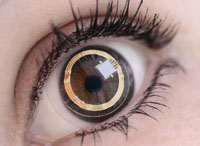 | |
| Senslmed's Triggerfish lens records changes in corneal curvature that correspond with intraocular pressure. |
The ability to monitor IOP over the course of a day is considered one of the holy grails of glaucoma assessment. While the FDA has not approved any such device in the US, a number of countries, including Canada and Australia, have approved the Triggerfish system, designed by Sensimed.
Triggerfish is a soft, disposable silicone hydrogel lens that functions as a strain gauge, measuring changes in corneal curvature that are then converted to units of change.
“The system consists of a silicone contact lens that is embedded with an antenna, strain gauge and microprocessor,” says Leo Semes, OD, professor of optometry at the University of Alabama in Birmingham. “This component translates choroidal pulses into a signal that is picked up by another antenna worn on the patient’s orbit, which is connected by a detachable cable to a data recorder that the patient wears.”
The Triggerfish system monitors IOP changes throughout the day, and provides detailed data with every recording. This data can be downloaded to a computer and used to map the patient’s IOP over a 24-hour cycle.
“The instrument takes a measurement every five minutes, or 288 times per day, and obtains 300 data points at each measurement,” says Ben Gaddie, OD, who practices in Louisville, Ky. “The doctor would fit and dispense the device and the patient would wear it for a few days, return it, and the doctor would then download and see the data.”
According to Murray Fingeret, OD, who practices in New York, the lens appears to be tolerated well, and has exhibited promising results.
“Initial reports show that IOP varies throughout the 24-hour period, similar to work performed in the University of California San Diego sleep lab, which shows the IOP is highest during the nocturnal hours,” says Dr. Fingeret.
“In addition, initial reports suggest that not all patients have perfectly reproducible 24-hour IOP behavior,” adds Dr. Semes. “Knowing a complete 24-hour cycle of IOP and its variability may change management, or explain why some patients show progression when IOP appears in the normal or ‘target’ range.”
The Triggerfish system may be a valuable tool, as it allows clinicians to customize IOP management based on the individual patient needs. For instance, given the differing efficacy of glaucoma medications during sleep, clinicians may be able to choose a more appropriate drug regimen for evening use based on the individual’s diurnal IOP curve.
“Because some individuals show greater changes in IOP than others, this device would allow therapy to be customized to the person based upon the way their IOP varies throughout the duration of the day,” says Dr. Fingeret
“Twenty-four hour IOP monitoring would allow us to gain perspective in two types of patients: those who are already progressing and any patient being staged for glaucoma treatment,” adds Dr. Gaddie. “If we know that someone has a large nocturnal IOP swing, that patient’s target IOP could be adjusted lower, or perhaps a surgical method might be better served to control nocturnal IOP elevation.”
More information is available here.

